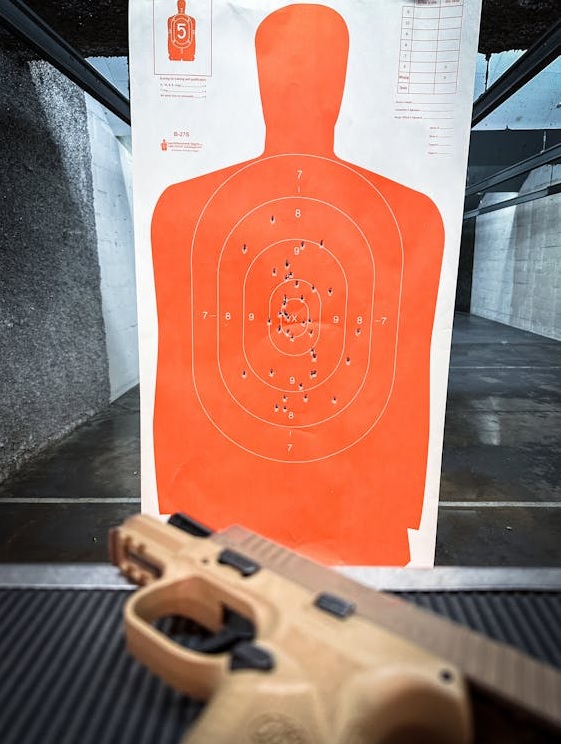Shooting a handgun accurately is arguably harder than shooting a rifle accurately, at least at intermediate ranges. That is, it is a lot easier to be accurate with a scoped rifle at 200 yards than it is with a handgun at 50, whether the handgun has an optic or not.
Handguns are harder to stabilize, harder to control, and let’s face it, in common calibers, the recoil from most handguns is more jarring than from a rifle.
And so, handgun shooters, especially beginners, often run afoul of problems that cause their shots to trend wide of the point of aim.
These are among the most common of them, how you can identify them, and what to do to solve the issue at the source. You’ll need to know what’s going on before you can load up on 9mm bulk ammo and break the bad habits at the range.
Terms You Need to Know
Before we can illustrate, diagnose, and prescribe cures to common problems, there are some terms we need to get out of the way so we can talk the same lingo. Expect to see he following terms in gun shooting materials:
- Thumbing: Thumbing basically means you’re applying too much pressure to the gun with your shooting hand’s thumb, hence the name. Thumbing tends to drive the barrel towards the shooter’s strong side, resulting in shots that trend wide right for a right-handed shooter.
- Heeling: Heeling is applying pressure to the grip of the handgun with the heel of your shooting hand.
- Jerking: Jerking, or jerking the trigger, means that you are getting too tense before firing and applying rapid, unnecessary pressure to the trigger (and the gun) - much more than is needed to break the trigger. Jerking can result in a variety of issues with accuracy. It is akin to flinching (see below).
- Double tapping: Double tapping usually occurs when firing rapidly and, to illustrate it as basically as possible, is when you pull the trigger once you have reacquired the target but before you have aligned your sights. At close ranges, the issue is negligible, but once you move back from the target the issue gets magnified.
- Grip pressure: Grip pressure is exactly what it sounds like; how hard you are gripping the gun. Squeezing the gun too hard can torque your barrel and sights off of the target; gripping too loosely can result in limp-wristing and jamming.
- Flinching: Flinching may also be called anticipation. What occurs is that you respond to the recoil of the gun before the trigger breaks. The problem here is that you move your sights off the target before the bullet starts moving through the barrel, resulting in inaccurate shots.
Now, Looking at the Target…

Sometimes you can diagnose the issue on your own, sometimes you can tell by looking at where the shots group on the target. Let’s take a look at the latter consideration (assuming a right-handed shooter).
- Shots grouping high: If your groups are trending high, the problem is probably that you’re breaking your wrist up before the shot.
- Shots grouping low: If your shots are grouping low, there’s a good chance that you’re breaking your wrist down, pushing the gun forward, or flinching.
- Shots clustering to the right of point of aim: You’re thumbing or squeezing the gun too hard, or you’re using too much trigger finger. That is, too much of your finger is laying across the blade of the trigger.
- Shots clustering to the left of point of aim: In this scenario, the issue is likely that you’re not using enough trigger finger and that only the tip of your finger is in contact with the trigger.
While these are the most common issues you’re most likely to experience when shooting a handgun, it’s also possible your shots are grouping either high or low and trending left or right, so we’ll look at these, too.
If your shots are clustering high and to the right, you’re probably heeling; if they cluster low and to the right, you’re probably tightening your grip in anticipation of the trigger breaking. Both of these can be considered precursors to a flinch.
If your shots are breaking up and to the left, you’re anticipating recoil or not following through. You might also not be gripping the gun with enough force. If they’re breaking down and to the left, you’re tightening your grip through the fingers in anticipation of the trigger breaking. This is one form of gripping the gun too tightly, which torques the barrel away from the shooter’s dominant side.
Get Some 9mm Bulk Ammo and Hit the Range!
Now that you can recognize some of the most common problems associated with inaccurate shot placement, the next thing to do is get to the range and rectify the problem by drilling until you’re a more confident, more proficient shooter.

